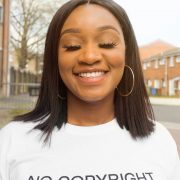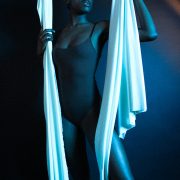“Vincent Van Gogh also had this”: Student and Painter Rafah Mohamed on living with Visual Snow Syndrome in the 21st Century


—
The daughter of two immigrants – an Iraqi father and a Palestinian-Syrian mother, 21 year-old Rafah Mohamed is a multi-lingual painter, student and aspiring poet living with an incredibly rare eye condition called Visual Snow Syndrome; a condition yet still to be recognised by many mainstream doctors. Those affected find their vision is busied by a kind of snow, or television-like static, sometimes accompanied by lights or other afterimages that “linger like a visual hangover”. With less than 200 documented cases globally, help for visual snow is not currently available on the NHS, but Rafah is not allowing this to impact her creativity.
An avid painter, she has drawn inspiration from Vincent Van Gogh and decided to recognise and focus on both the uniqueness of her condition and how this allows her to paint things that no-one else will ever be able to see.
—

—
“I moved to London aged 9 from Netherlands. Due to war, I’ve never been able to visit any of the countries that my parents emigrated from.”
Responding to “Who is Rafah Mohammed” – although hesitating momentarily – Rafah’s face lights up as she decides upon her approach to tackling the question:
“I’m quite shy and reserved naturally. I’ve always been a dreamer, so I knew exactly where I wanted to end up – despite everything.” She goes on to explain that she has always had a working diary of things that she wanted to do with her life and that being diagnosed with visual snow syndrome in February 2017 hasn’t stopped these plans.
“It sometimes replicates a lot of the symptoms of having a migraine. Right now whilst we have this conversation I can see my white blood cells in the sky, my eye protein over you, constant static, images, flashing lights.”
—

—
Rafah is balancing her creativity with a degree in International Development at the University of East Anglia. “I am currently at university and not receiving any of the adjustments that someone with such a condition should get.” She goes on to describe how there have unfortunately been four student suicides at her university this year and how this is indicative of insufficient attention being paid to serious issues.
“It is this feeling of justice being taken away through the lens of disability discrimination that encourages me to return to creativity, as an outlet.”
She describes the challenges she has faced and how it has affected a lot of things but has actually made her resilient and allowed her to thrive creatively. She paints a beautiful picture of how her condition may actually be one of her biggest gifts as she is able to create art that no-one else will ever be able to see and to create it in a completely different way to everyone else. “A lot of people don’t know this but Vincent Van Gogh also had visual snow syndrome – when he is painting the ‘stars in the sky’, he is actually painting what his visual snow allows him to see”.
—

—
The way that Rafah has managed and continues to manage to find positives in what she deals with certainly does not take away from the gravity of the condition. “As with most neurological conditions, there is a spectrum of disability, and some patients do find the phenomenon disabling… this is especially true at the onset of the syndrome” says specialist Victoria S. Pelak, MD, FAAN, professor of neurology and ophthalmology and director of the neuro-ophthalmology fellowship at the University of Colorado School of Medicine.
Overlayed with transcendental racial discrimination, hostility, and having to continue to navigate a patriarchal system not designed in her favour, the barriers to professional and creative success that Rafah faces can be very tough to overcome. In the context of racial discrimination, she speaks about the Grenfell Tower tragedy, how it affected her personally and how disappointed she is in the way that the government has handled things, before recounting a poem that she wrote in its aftermath:
—
For all who have forgotten this is a reminder. Grenfell did not happen too long ago. The majority of people who were murdered in Grenfell were from ethnic minorities.
Notice I use the word ‘murdered’. £10 million supposedly used for refurbishment.
Instead used for cheap cladding.
So that the sight doesn’t offend the almighty rich, white, and wealthy of Chelsea and Kensington.
“This was a terrible tragedy that took place,” says Theresa May.
No Theresa this wasn’t some natural disaster. Usually, you can come up with names like tic tac’s in an hour.
When it’s a terrorist attack you attack any followers of Allah. But when the victims don’t have your shade of skin its a ‘tragedy’ a true sin.
But sinners don’t always roam the streets at night, no just hand any Tory politician a mirror so they can see their own sight.
Among them, an immigrant family from Syria just having escaped a fire to be trapped in an inferno.
Politicians making more money increasing their salaries yet we couldn’t put aside £5k for Grenfell families.
And instead watched people scream from their windows.
Guess you never wanted them in your boroughs.
Among them Khadija Saye a young artist. Among them children and innocents.
Theresa there’s one thing I’d like to say to you. You might have your wealth of armour now. Your laughing yes men and caviar.
But there’s a place that Grenfell victims went that you can’t buy your way into.
Heaven Theresa, cos’ trust me this is nothing compared to the palace of God.
They say God gives his toughest battles to his toughest soldiers. Rest in peace Grenfell. I promise you, you’ll never be forgotten. God’s little soldiers.
—


—
With visual snow being so rare, Rafah recounts her luck at being diagnosed by a Swedish doctor, with specialism in the area, who happened to be temporarily visiting Moorfields – the hospital that she checked herself into once the symptoms started to show.
“Most doctors don’t recognise this as a real thing and it’s not on the NHS”.
She decides to focus on paying it forward, providing some tips for others who may be living with visual snow syndrome:
“You’re not not normal, you’re okay. You just have a condition that is not known in the mainstream but should be taken as seriously as any other disability.”
“People not making reasonable adjustments for your visual snow syndrome (oftentimes just requiring text to be displayed on a blue screen) is just like taking a wheelchair away from someone.”
I can sense her frustration.
A calmer and more relaxed Rafah then turns onto the topic of her mental health, and how this affected her creative journey as a painter. “My paintings are a direct reflection and expression of what I feel and see. At one point as a teenager, my paintings became very dark and that scared me… I had to take a break and come back to it.” She goes onto describe how taking control of one’s anxiety can ensure that it doesn’t dictate your life or stand as a block to your creativity.
“I feel like taking control of my anxiety allowed me to regain a part of myself that I never thought I lost.”
—

—
We finish our conversation with a discussion on where she sees her creative journey taking her:
“We don’t really speak about how creativity can be channelled into technology, but one thing that my condition has given me is the ability to code. The way that I see things is incredibly unique – I’m not the greatest mathematician, but I managed to self-teach myself how to code in two weeks, create a programme and do some art with that. I see it opening doors for me.”
Rafah is available for commissions at rafahrazm@icloud.com.
More information on the symptoms of visual snow syndrome can be found here. If you think that you may be suffering from the condition, contact Moorfields Eye Hospital on +44 20 7253 3411.
—






![ZINO VINCI’S ‘FILTHY & DISGUSTING’EP BRINGS YOU TO THE CORE OF THE ARTIST [@ZinoVinci]](https://guap.co/wp-content/uploads/2023/10/Zino-4.jpg)





![Remel London’s [@Remel_London] “Mainstream” is a must attend for upcoming presenters!](https://guap.co/wp-content/uploads/2017/02/REMEL-LONDON-FLYER-FINAL-YELLOW-COMPLETE-1.png)